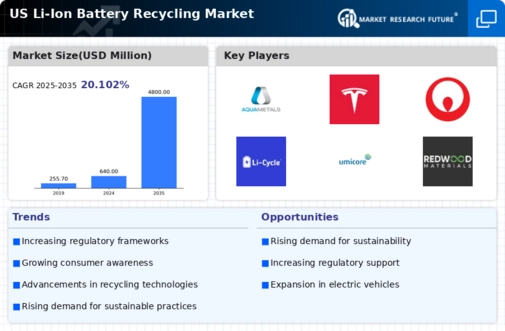The US Li-Ion Battery Recycling Market is experiencing substantial growth, driven by the increasing demand for sustainable solutions in the face of rising environmental concerns. As the shift towards electric vehicles and renewable energy storage accelerates, so too does the need for efficient recycling methods that can recover valuable materials from spent lithium-ion batteries. The competitive landscape is characterized by a mix of established players and emerging startups, all vying for a share of this lucrative market. Key trends influencing competition include advancements in recycling technology, regulatory frameworks promoting sustainability, and partnerships aimed at enhancing capacity and efficiency.
Understanding these dynamics is critical for stakeholders looking to navigate the complexities and capitalize on the opportunities presented by the evolving market.Battery Resourcers is a notable player in the US Li-Ion Battery Recycling Market, drawing on its unique strengths that position it effectively against competitors. The company specializes in the development of innovative processes to recycle lithium-ion batteries, aiming to recover lithium, nickel, and cobalt with high efficiency. Its proprietary technologies not only minimize waste but also ensure the sustainability of resource recovery.
Operating with a focus on efficiency and environmental responsibility, Battery Resourcers has established strategic partnerships that enhance its market presence.
These collaborations are pivotal in scaling their operations and advancing their recycling capabilities, ultimately solidifying their position in the rapidly evolving landscape of battery recycling in the US.Aqua Metals stands out in the US Li-Ion Battery Recycling Market with its sustainable approach to battery recycling, leveraging proprietary technology to recover key materials from lithium-ion batteries while minimizing waste. The company focuses on the use of its AquaRefining technology, which offers a non-polluting, hydrometallurgical process. This innovation places Aqua Metals at the forefront of environmentally-friendly recycling efforts in the region.
The company has made significant strides in establishing a strong market presence, with facilities designed to process a substantial volume of batteries. Through strategic mergers and acquisitions, Aqua Metals has bolstered its capabilities and expanded its influence, allowing it to enhance product offerings and broaden its operational reach within the US market. Their commitment to sustainability and advanced technology further fortifies their competitive edge, meeting the growing demand for responsible battery recycling solutions.

















